
Laboratory of taiga ecosystems and biodiversity
Chief of the laboratory, Doctor of the Agricultural Sciences, the main researcher – Tarakanov Anatoly Mikhailovich.
The laboratory includes:
-
Sector of silviculture and forestry;
-
Sector of forest conservation and protection;
-
Biodiversity sector.
SECTOR OF SILVICULTURE AND FORESTRY
Sector of Silviculture and Forestry is created on the base of Laboratory of Taiga Forestry. The beginning of the organization Laboratory of Forestry is establishment of independent forestry group in 1939 as a part of Northern base of the USSR Academy of Science. The leader was I.S. Melehov, Academician of the All-Russian Academy of the Agricultural Sciences. After the establishment of the Institute of Forest and Forest Chemistry of the USSR Science Academy in 1958, the group was reorganized into the Laboratory of Silviculture and Forestry on the base of which the Laboratory of Forestry has been based in 1976.
The main directions of research:
-
Improvement of the methods of main forest exploitation cuttings and thinning, studying the regularities of reforestation processes in forests and on the cuttings;
-
Development of measures for improvement of forest species composition and their productivity increase;
-
Development of issues related to the use of mineral fertilizers application in coniferous forests; fire protection of forests.
The Laboratory conducted great research for elaboration of cutting typology and dynamic typology theory. The regularities of forest reproduction in connection with cutting types and seed tree availability were assessed. Preservation and damage rates of understory by different methods and technologies of harvesting were studied. The regularities of offspring forming and species changes on concentrated cuttings were determined. Resources of forest flammable materials, frequency of fire occurrence, main regularities of occurrence, development and expansion of forest fires were studied.
There was implemented forestry-economic explanation of different cutting methods taking into account forest conditions, forest target purpose, age structure and composition of forest stands. A system of cutting methods for derivative stands, spruce and pine forests of all forest groups was elaborated. Also there were suggested a narrow-cut method of harvest area working out with preservation of undergrowth and new variants of non-clear cuttings for spruce forests of different age. Application of long-gradual cuttings in pine-spruce stands and strip-gradual cuttings in pure pine stands was explained. There were developed modes of cuttings and forestry requirements to methods and technologies of logging using home-produced and foreign equipment. Influence of harvesting equipment on plant growing soil properties was studied.
The laboratory studied physiological state of coniferous species undergrowth on cutting areas of different age and under cover of native and derivative forests. The significance of preserved undergrowth to reforestation on concentrated cuttings, reduction of cutting period rotation and increase of forest exploitation volume was shown.
In the laboratory, there were developed regimes of improvement cuttings in pure and mixed pine forests, birch-spruce, aspen-spruce and spruce-birch stands on zone-typological base. Also methods and ways of thinning were specified, and their program was developed. Forestry-economic efficiency of improvement cuttings and their ecological role were defined.
For improvement of forest fire protection, there were developed: forest-fire zoning of the woods of the European North; standards for placement of fire-chemical stations, fire lookout points and fire waters; standards for placement of mineralized strips within coniferous stands; local scales of fire danger for forests of the European North; and measures for forest fire fighting unit of the European North.
Researchers of the laboratory have published about 600 papers. Research results have been summarized in instructive documents (specifications, instructions, guidance’s, manuals and recommendations).
Much attention is paid to introduction of scientific developments into industry: on the leshozes of Arkhangelsk and Vologda regions and Komi Republic, and also on logging enterprises and in forest management. The most significant normative documents elaborated with participation of our researchers are widely used:
-
Key points on cuttings of the main forest exploitation in Russian Federation (М., 1994);
-
Key points on thinning in the forests of Russia (М., 1993);
-
Regulations for cuttings of the main forest exploitation in plain forests of the European part of Russian Federation (М., 1994);
-
Instructions for improvement cuttings in plain forests of the European part of Russia (М., 1994);
-
Guidance for organization and technology of cuttings of the main forest exploitation cuttings of the main and intermediate forest exploitation in soft-wooded stands with the second story and understory of coniferous species (М., 1997) etc.
The works of the laboratory were demonstrated on VDNKh (All-Union Exhibition of Achievements of National Economy).
Some of our researchers were awarded with medals. For specialists of forestry and timber industry, there are held workshops on clear and partial (selective, gradual, complex) cuttings of main exploitation and improvement cuttings in compliance with silvicultural requirements.
Since 1963 till 1970 the laboratory was under the guidance of V.G. Chertovskoy, Candidate of the Agricultural Sciences, senior researcher, and since 1971 till 1980 – G.A. Chibisov, Candidate of the Agricultural Sciences, senior researcher.
During many years successful researchers of the laboratory were Academician I.S. Melekhov, Candidates of the Agricultural Sciences: V. G. Chertovskoy, L.I. Korkonosova, A.V. Patranin, A.L. Parshevnikov, A.A. Karelina, A.I. Stalskiy, Z.A. Mironova, I.I. Ivanova, I.V. Volosevich, V.I. Kashin, V.N. Drachkov, N.I. Vyalykh, A.Ya. Lazarev, A.A. Zvonkova, V.A. Anikeeva, G.A. Chibisov, Z.I. Gulaya, S.A. Moskaleva, M.M. Krukova, L.E. Kryzhanovskaya, L.G. Gogoleva, B.A. Semenov, A.I. Artemiev, B.N. Ogibin etc.
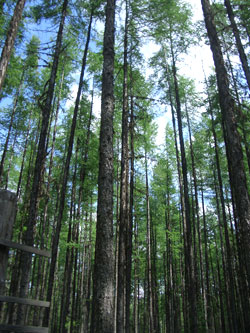
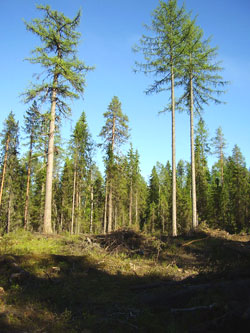
SECTOR OF FOREST PROTECTION
The sector was established on the base of two Laboratories of Pre-Tundra Forestry and Forest Amelioration. With the increase of intensity of industrial development of the Far North territories, problems connected with the northern nature protection and development of a strategy of sustainable resource utilization became relevant. Therefore in May, 1991 a group of researchers was selected into separate structural subdivision of the institute to develop principles of multipurpose environment-friendly exploitation of pre-tundra forests. The first chief of the Laboratory of Pre-Tundra Forestry was B.A. Semenov, Candidate of the Agricultural Sciences, to whom belong the most long-term latest studies on characteristics of forest communities of this zone.
Scientific statement of the problem of pre-tundra forestry with ecological-protection purposes was clearly indicated as long ago as the period of the institute`s establishment and was connected with the name of the Academician I.S. Melekhov. At different times the following researchers participated in studies: P.N. L’vov, Doctor of the Agricultural Sciences; Candidates of the Agricultural Sciences: A.L. Parshevnikov and V.G. Chertovskoy; researchers: L.I. Korkonosova, F.P. Yelizarov, V.A. Melnik, V.I. Kashin and others. An important contribution to knowledge about these forests was made by researchers of Murmansk Regional Laboratory of the institute: V. F. Tsevetkov, Doctor of the Agricultural Sciences; Candidates of the Agricultural Sciences: V.V. Repnevsky and A.L. Fedorkov; researchers: I.B. Beletsky, E.A. Chekrizov, I.I. Sizov, R.P. Pankratov and others.
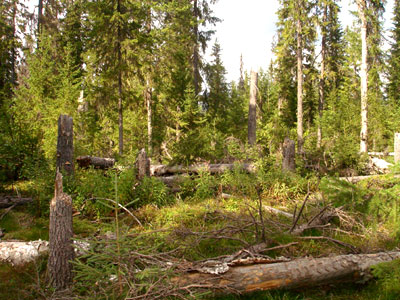
As a result of broad (from Murman to the Urals) and long-term complex studies carried out by two generations of our scientists, there was established a scientific concept of pre-tundra forests, also there were worked out a view about their nature and economic significance. Criteria of pre-tundra forest was defined; regularities of stands growth and composition, their restoration ability and medium-forming functions were studied; forest territory zoning was implemented; and assessment of anthropogenic impact scales and intensity was given. Recently there was defined more precisely the southern border of pre-tundra forest zone on the European territory, also there was outlined its climatic boundary for the Asian part of Russia.
On the base of research materials there were published three monographs, numerous articles and reports in different magazines, books, and proceedings of different workshops. Also there were elaborated 10 practical guidelines and user`s guides, effectiveness of which was confirmed during experimental-production verifications and introductions. Many of them are used in the process of forest management for explanation and design of forestry measures.
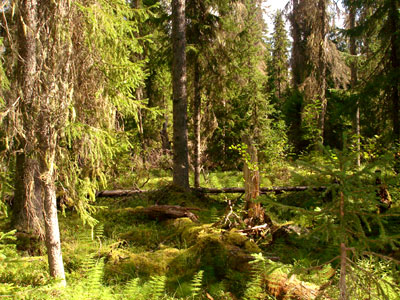
The institute implemented great organizational work in pre-tundra forests research accomplishing coordination of studies within the system of former Rosleskhoz on this problem and carrying out two All-Russian conferences.
Sources of establishment of the Laboratory of Forest Amelioration relate to 1939 when independent forest management group was set up within the Botanic Sector of the Northern Base of USSR Science Academy. In 1958 the group reorganized into the Laboratory of Silviculture and Forestry on the base of which in 1976 there were established laboratories of Silviculture and Forest Amelioration with the group of Woody Plant Physiology and the laboratory of Forestry.
The main directions of research:
- Northern forest nature study and elaboration of scientific bases for forestry conduction;
- Elaboration of swamped forests productivity increase methods using hydrotechnical amelioration;
- Establishment of regularities of environment changing, stands growth and development under the influence of water forest amelioration;
- Study of wood species physiology and ecology features in connection with different forestry measures.
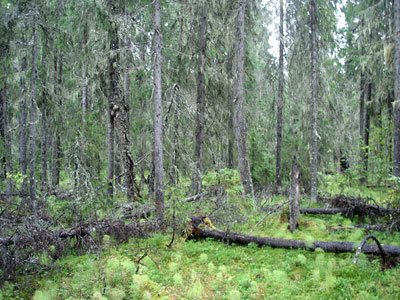
As a result of long-term work of the laboratory, natural and ecological- physiological features of swamped forests and efficiency of their draining, regularities of stand growth and development, influence of amelioration on timber defects occurrence, stacked-volume ratio of stems, marketable structure of stands, natural forest reproduction, surface cover, soil hydrothermal regime and their physical and chemical properties were studied. The maturity and cutting ages of drained forests, rates of their drainage and parameters of drainage net were explained. Also there were elaborated technological schemes and technical-economic rates of different variants of drainage net, methods of determination of forestry and economic efficiency of forest draining, classification of swamped forests by groups of drainage efficiency, recommendations for design, maintenance and improvement of water forest reclamation systems, drained forest management, also tables of growth rates of modal pine and spruce stands, assortment and marketable tables, practical policies for quality control and efficiency of forest draining in forest management, recommendations for optimization of water forest reclamation systems and improvement of drained forests structure, simulation models for forecasting of technical state of amelioration net, growth and productivity of plantings for 100-year period, regulations of cuttings of the main forest exploitation and directions for thinning in drained forests.
During studies on physiology and ecology of wood species, the main attention was paid to metabolism processes: photosynthesis, root and foliage respiration, organic and mineral substances movement and uptake, transpiration of coniferous species and plants of living ground cover. Also there was studied the reaction of wood species on draining, application of mineral fertilizers, fires, different ways of cutting and tapping, and features of woody plants functioning in the conditions of Far North.
Research results were reflected in series of monographs, symposium proceedings, and scientific magazines. Also practical guidelines regulating forestry in the European North were worked out.
There were established constructive connections with several research and planning institutes and many regional forestry enterprises.
At different times the laboratory was under guidance of the Academician I.S. Melekhov, Candidates of the Agricultural Sciences: V.G. Chertovskoy and A.I. Artemiev. Since 1991 the chief of the Laboratory is A.M. Tarakanov.
SECTOR OF BIODIVERSITY
The sector of biodiversity was established on the base of the Laboratory of Woody Plant Introduction (see Dendrological Garden).



